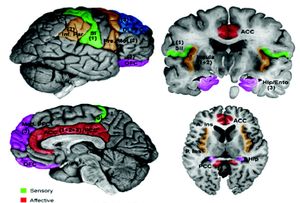Opioids: Difference between revisions
Justin Bryan (talk | contribs) No edit summary |
Justin Bryan (talk | contribs) No edit summary |
||
| Line 3: | Line 3: | ||
== Introduction == | == Introduction == | ||
[[File:OxyContin branded oxycodone 10mg (OC side).jpg|right|frameless|250x250px]] | [[File:OxyContin branded oxycodone 10mg (OC side).jpg|right|frameless|250x250px]] | ||
An opioid refers to any substance from a group of analgesic agents derived from the ingredient opium. Opioids are a type of depressant, analgesic drug that slows down the messages being sent through the central nervous system between the body to the brain. Although used to treat pain, opioids can entice euphoric feelings and sedative effects which can be addictive, which makes abuse of this drug group increasingly common. | An opioid (exogenous opioid) refers to any substance from a group of analgesic agents derived from the ingredient opium. Opioids are a type of depressant, analgesic drug that slows down the messages being sent through the central nervous system between the body to the brain. Although used to treat pain, opioids can entice euphoric feelings and sedative effects which can be addictive, which makes abuse of this drug group increasingly common. | ||
Opioids can be naturally occurring, synthetic, or semi-synthetic depending how they are derived. Natural and semi-synthetic opioids utilize substances extracted from opium, which is produced from the dried seeds of the opium poppy. Fully synthetic opioids, on the other hand, are derived using laboratory methods to produce the same compounds naturally found in opium through controlled chemical processes. A least 20 different compounds are found in opium; these biologically active substances can either produce analgesic effects directly (i.e. morphine), or act as precursors that can be used to produce other analgesic drugs including semi-synthetic opioids.<ref>Ciccone CD, editors. Pharmacology in Rehabilitation. 5th Ed. Philadelphia: F.A. Davis Company, 2016. p202-218.</ref> | Opioids can be naturally occurring, synthetic, or semi-synthetic depending how they are derived. Natural and semi-synthetic opioids utilize substances extracted from opium, which is produced from the dried seeds of the opium poppy. Fully synthetic opioids, on the other hand, are derived using laboratory methods to produce the same compounds naturally found in opium through controlled chemical processes. A least 20 different compounds are found in opium; these biologically active substances can either produce analgesic effects directly (i.e. morphine), or act as precursors that can be used to produce other analgesic drugs including semi-synthetic opioids.<ref name=":0">Ciccone CD, editors. Pharmacology in Rehabilitation. 5th Ed. Philadelphia: F.A. Davis Company, 2016. p202-218.</ref> | ||
== Clinical Pharmacology == | == Clinical Pharmacology == | ||
Production of opioids begins with four naturally occurring alkaloids which can be isolated from the opium poppy seed (p''apaver somniferum).'' These plant-derived amines, which include morphine, codeine, papaverine and thebaine, can then be used to produce many varieties of semi-synthetic opioids useful in clinical medicine. Common semi-synthetic opioids derived from these four substances include diamorphine, dihydrocodeine, buprenorphine, nalbuphine, naloxone and oxycodone.<ref name=":1">Pathan, H., & Williams, J. (2012). [https://www.ncbi.nlm.nih.gov/pmc/articles/PMC4590096/ Basic opioid pharmacology: an update.] ''British journal of pain'', ''6''(1), 11-6.</ref> | |||
Opioids | Opioids exert their analgesic properties by binding to specialized "opioid" receptors that already exist on the neurons at specific sites in the central nervous system. These receptors exist in concert with endogenous (produced by within the body) opioid-like substances, both of which act as part of the body's natural process of controlling pain and inflammation. The three groups of endogenous opioid-like substances include endorphins, enkephalins, and dynorphins. In addition to pain control, endogenous opioid-like substances are believed to play a role in other processes including response to stress, immune modulation, GI function, eating and others.<ref name=":0" /> | ||
There are three major types of opioid receptor, 𝜇, 𝛿, and 𝜅 (mu, delta and kappa), found throughout the body. Other opioid receptors do exist, i.e. nociceptin/orphanin FQ peptide receptors, however no know exogenous opioid has been found to specifically act upon them. As such, opioids are commonly classified by their ability to exert an effect by binding to one of the three main receptors (𝜇, 𝛿, and 𝜅). All 3 receptors will produce analgesia when binded with an opioid substance, but the degree of effect is determined by how strongly a given opioid binds to a given receptor. This degree of "affinity" produces further sub classifications under each receptor type.<ref name=":0" /><ref name=":1" /> | |||
Of the three opioid receptor types, each produces analgesic effects when a substance binds to it. That being said, each receptor type a produce unique and distinct spectrum of impacts when activated. This specificity can be useful in choosing a specific opioid to target a patient's unique symptoms. Common unique effects of each receptor are listed below:<ref name=":0" /> | |||
* Mu (𝜇) - Sedative effects, depression of respiratory function, constipation, reduction in release of neurotransmitters | |||
* Delta (𝛿) - Sedative effects, constipation, psychoactive effects | |||
* Kappa (𝜅) - Heightened release of hormones, reduction in release of neurotransmitters | |||
== Benefits & Drawbacks of Opioids == | == Benefits & Drawbacks of Opioids == | ||
Revision as of 21:51, 14 February 2023
Introduction[edit | edit source]
An opioid (exogenous opioid) refers to any substance from a group of analgesic agents derived from the ingredient opium. Opioids are a type of depressant, analgesic drug that slows down the messages being sent through the central nervous system between the body to the brain. Although used to treat pain, opioids can entice euphoric feelings and sedative effects which can be addictive, which makes abuse of this drug group increasingly common.
Opioids can be naturally occurring, synthetic, or semi-synthetic depending how they are derived. Natural and semi-synthetic opioids utilize substances extracted from opium, which is produced from the dried seeds of the opium poppy. Fully synthetic opioids, on the other hand, are derived using laboratory methods to produce the same compounds naturally found in opium through controlled chemical processes. A least 20 different compounds are found in opium; these biologically active substances can either produce analgesic effects directly (i.e. morphine), or act as precursors that can be used to produce other analgesic drugs including semi-synthetic opioids.[1]
Clinical Pharmacology[edit | edit source]
Production of opioids begins with four naturally occurring alkaloids which can be isolated from the opium poppy seed (papaver somniferum). These plant-derived amines, which include morphine, codeine, papaverine and thebaine, can then be used to produce many varieties of semi-synthetic opioids useful in clinical medicine. Common semi-synthetic opioids derived from these four substances include diamorphine, dihydrocodeine, buprenorphine, nalbuphine, naloxone and oxycodone.[2]
Opioids exert their analgesic properties by binding to specialized "opioid" receptors that already exist on the neurons at specific sites in the central nervous system. These receptors exist in concert with endogenous (produced by within the body) opioid-like substances, both of which act as part of the body's natural process of controlling pain and inflammation. The three groups of endogenous opioid-like substances include endorphins, enkephalins, and dynorphins. In addition to pain control, endogenous opioid-like substances are believed to play a role in other processes including response to stress, immune modulation, GI function, eating and others.[1]
There are three major types of opioid receptor, 𝜇, 𝛿, and 𝜅 (mu, delta and kappa), found throughout the body. Other opioid receptors do exist, i.e. nociceptin/orphanin FQ peptide receptors, however no know exogenous opioid has been found to specifically act upon them. As such, opioids are commonly classified by their ability to exert an effect by binding to one of the three main receptors (𝜇, 𝛿, and 𝜅). All 3 receptors will produce analgesia when binded with an opioid substance, but the degree of effect is determined by how strongly a given opioid binds to a given receptor. This degree of "affinity" produces further sub classifications under each receptor type.[1][2]
Of the three opioid receptor types, each produces analgesic effects when a substance binds to it. That being said, each receptor type a produce unique and distinct spectrum of impacts when activated. This specificity can be useful in choosing a specific opioid to target a patient's unique symptoms. Common unique effects of each receptor are listed below:[1]
- Mu (𝜇) - Sedative effects, depression of respiratory function, constipation, reduction in release of neurotransmitters
- Delta (𝛿) - Sedative effects, constipation, psychoactive effects
- Kappa (𝜅) - Heightened release of hormones, reduction in release of neurotransmitters
Benefits & Drawbacks of Opioids[edit | edit source]
Opioids can produce profound analgesia for patients with acute pain. Opioids are very effective at treating acute pain due to their ability to inhibit pain signal transmission at multiple stages in the pain pathway and their ability to enhance the inhibitory pain fibres.
There are many adverse effects associated with opioids. Kappa receptor stimulation is associated with side effects such as hallucinations, dysphoria, anxiety and restlessness. Delta and mu receptor stimulation is often dangerously associated with respiratory depression as the body is unable to regulate carbon dioxide levels in the body effectively. Other drawbacks associated with opioid use in general include sleep apnoea, hypothalamic-pituatory axis supression (hormonal changes with the potential for decreased libido, infertility & fluid retention), urinary retention, nausea & vomiting, physical dependence and addiction, opioid-induced hyperalgesia, dental pathology, constipation, increased mortality and tolerance.[3]
Considerations in Physiotherapy[edit | edit source]
Opioids are regularly administered for the treatment of pain; many patients that present to physical therapists may have already been prescribed them. Our role within any multidisciplinary management team treating a person who has pain is to ensure that we are monitoring the safe and clinically indicated use of opioids if required, identifying the potential for adverse effects and recognising these in a timely manner. The video clip below highlights the signs to look for re addiction to opioids
Opioid use is also linked to increased falls risk. A 2018 retrospective, observational, multicentre cohort study the findings were that recent opioid use is associated with a greater risk of falls in older adults and a greater likelihood of death in those with fall-related injuries.[4]
Opioids alone are not a solution for chronic pain as supported by an abundance of literature. [6][7][8]
The image below shows the many areas involved in the brain with pain processing.
References[edit | edit source]
- ↑ 1.0 1.1 1.2 1.3 Ciccone CD, editors. Pharmacology in Rehabilitation. 5th Ed. Philadelphia: F.A. Davis Company, 2016. p202-218.
- ↑ 2.0 2.1 Pathan, H., & Williams, J. (2012). Basic opioid pharmacology: an update. British journal of pain, 6(1), 11-6.
- ↑ Prescription Opioid Policy. A publication by The Royal Australian College of Physicians, Faculty of Pain Medicine ANZCA, The Royal Australian College of General Practitioners and The Royal Australian and New Zealand College of Psychiatrists.
- ↑ Daoust R, Paquet J, Moore L, Émond M, Gosselin S, Lavigne G, Choinière M, Boulanger A, Mac-Thiong JM, Chauny JM. Recent opioid use and fall-related injury among older patients with trauma. CMAJ. 2018 Apr 23;190(16):E500-6. Available from: https://www.ncbi.nlm.nih.gov/pmc/articles/PMC5915247/ (last accessed 9.4.2019)
- ↑ Fox 47 news. Opiod use linked to increased risk of falls. Available from: https://www.youtube.com/watch?v=mYrQUj2yecs&app=desktop (last accessed 9.4.2019)
- ↑ Reinecke H, Weber C, Lange K, Simon M, Stein C, Sorgatz H. Analgesic efficacy of opioids in chronic pain: recent meta‐analyses. British journal of pharmacology. 2015 Jan;172(2):324-33.
- ↑ Manchikanti L, Kaye AM, Knezevic NN, McAnally H, Slavin K, Trescot AM, Hirsch J. Responsible, safe, and effective prescription of opioids for chronic non-cancer pain: American Society of Interventional Pain Physicians (ASIPP) guidelines. Pain Physician. 2017 Feb 1;20(2S):S3-92.
- ↑ Walsh K. General practice pain management: beyond opioids. InBSAVA Congress Proceedings 2016 2016 Apr 1 (pp. 354-354). BSAVA Library.








